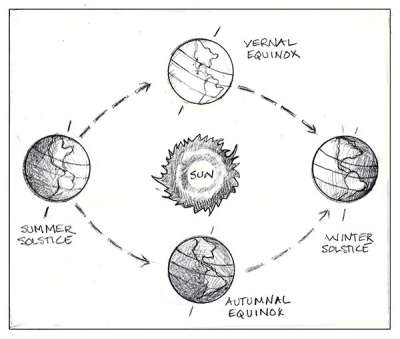
Every year, I eagerly await the winter solstice, which this year falls on December 21. My anticipation is driven not from an affection for winter, but a hunger for sunlight. I want the ever-shrinking days of autumn to be over and done and the slow, steady march towards late-evening sunsets to begin. So really it’s not the winter solstice I await, so much as being on the other side of it.
But this December I’ve decided to pay attention and learn more about the day itself. Turns out to have been a good choice, as this year’s solstice proves to be more interesting than most.
The winter solstice is the shortest day of the year in the Northern Hemisphere (and the longest on the southern side of the globe). It occurs because the earth's axis isn't perpendicular to its orbit around the sun, but is tilted by 23 1/2 degrees.
In winter, when the Northern Hemisphere is tilted away from the sun, the sun’s path is lower in the sky, and the light that reaches our part of the Earth’s surface arrives on more of a slant than it does in summer. Winter solstice occurs on the date when that effect is at its most extreme – when the northern half of the planet is tilted as far from the sun as possible.
Surprisingly, the earliest sunset of the year doesn’t occur on the solstice. Nor does the latest sunrise. I had always assumed the shortest day of the year included both - latest possible sunrise, plus earliest possible sunset would equal the shortest possible day. But that’s not accurate. The earliest sunset in the Northern Hemisphere takes place earlier, around December 7, and the latest sunrise won’t occur until January.
This is because the earth does not move in a perfect circle around the sun, explained John R. Thorstensen, professor of physics and astronomy at Dartmouth College.
“The earth's orbit is slightly elliptical, causing the sun to appear to move across the sky ever so slightly faster at some times of year than others,” said Thorstensen. “By early December, the sun is a little bit ahead of where it would be if its orbit were circular, leading to a ‘sun-fast’ condition.” The result is that our clocks say it’s noon, but the sun is already a bit west of the meridian, and will make its descent earlier than it would have otherwise. After December 7, added Thorstensen, the sun slowly starts to set later and later. By January,we’ll have the opposite ‘sun-slow’ condition, meaning that the sun will rise later and appear to move across the sky more slowly.
So the sun always sets later on the solstice than it does in the proceeding two weeks, but the total number of daylight hours will be fewer; on December 7 we enjoyed 9 hours and 26 minutes of sunlight, compared to 9 hours and 20 minutes on December 21.
In 2014, the winter solstice in the North will not only experience the longest night of the year, but those hours will also be marked by a lack of light. On December 21 there will be a new moon, which is to say no moon at all in the night sky.
For those of us who crave light, this may feel doubly cruel - a short day, followed by an exceptionally dark night. But there is - literally - a bright side. This year’s solstice also coincides with the peak of the Ursid meteor shower.
The Ursids are so named because they appear to come from within the constellation Ursa Minor, more commonly known as the Little Dipper. The showers take place annually between December 17 and 25, and this year the peak is in the early hours of December 22.
I am looking forward to the solstice, as I do every December. Only this time I will make sure to enjoy the later sunset, the moonless sky and, if conditions are right, the Ursid meteor shower. And then I will savor the ever-increasing hours of sunlight.


Discussion *